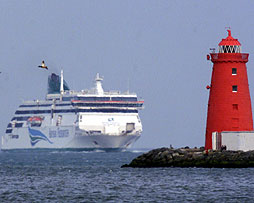Country Mouse No More
Although it was once the impoverished southern underperformer to an industrialized Northern Ireland (NI), the Republic of Ireland (ROI) roared ahead in the ’90s, becoming one of the most productive and successful economies of Europe. Many factors contributed to this astounding rebound, among them low corporate taxes, favorable demographics, and the fruits of earlier investment in higher education. Membership in the European Union also gave the Republic opportunities in the European market and qualified it for subsidies used to upgrade its infrastructure.
But while the South’s prospects soared, the North’s took a nosedive as political turmoil and the violence of The Troubles took their toll on the economy — 30 years of sectarian violence between Catholics and Protestants resulted in over 3,000 deaths and succeeded in frightening away foreign investment. At the same time, the North’s traditional manufacturing industries, such as textiles and shipbuilding, steadily lost ground due to globalization.
Foreign investment and the influx of high-tech companies have boosted the ROI’s economy well beyond that of NI — its gross national product (GNP) has increased by 400 percent since 1986. In contrast, political instability and industrial obsolescence made the NI economy overly dependent on United Kingdom (UK) subsidies and the public sector. Today public spending in NI still accounts for over 60 percent of the GDP, and the government employs about one in three workers, twice the number in the ROI.
Positive Signs
However, there are indications that the North is making economic inroads and perhaps experiencing a beneficial osmosis across the border. Foreign investment in NI has increased 45 percent over the past five years and tourists are slowly making their way back to beleaguered Belfast. While NI’s progress is still far behind the stunning growth of the Republic, NI now has an unemployment rate of about 4.5 percent, half that of a decade ago, and less than the 5.9 percent average rate in the UK.
Some of the positive changes stem from the same factors that boosted its neighbor and others can be attributed to overflow from the South. Like the ROI, NI has a highly educated English-speaking workforce. With its low cost of living and lower wages than the Republic, NI is attracting foreign investment in the same way the ROI did at the beginning of the Celtic Tiger phenomenon.
As the ROI has shifted its focus to more high-tech companies, there is a greater need for skilled workers. The Irish and an influx of immigrants meet many of these needs, but not all, creating opportunities for NI’s IT grads. Both North and South are looking at their technological infrastructure to see how they can attract the next wave of investment. Education is key, but other factors like broadband access are important, too. While the South is struggling to make this a priority, the North has completed a 100 percent access plan. The South, however, has announced a “Strategy for Science Technology and Innovation,” a planned investment of € 3.8 billion ($4.8 billion) in research in Ireland from 2006 through 2013. One of the goals of the program is to double the number of Irish Ph.D. graduates.
- Previous: A Tale of Two Economies
- Next: Ulster Tiger Ready to Spring?



